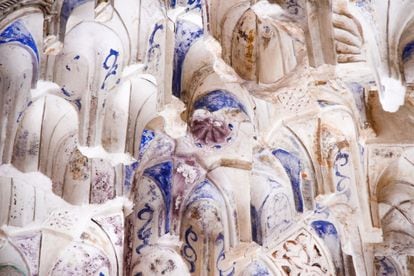Gold, alchemists, nanospheres: How the mystery of the Alhambra’s purple stains was solved
Two researchers from the University of Granada used electron microscopy to reveal why some of the gilded plasterwork in the world-famous monument has developed an unusual hue
/cloudfront-eu-central-1.images.arcpublishing.com/prisa/PJJXN5E4JJEWPMEYBPOXTUYM34.jpg)
Some parts of the Alhambra, the world-famous medieval Islamic monument in Granada (southern Spain), feature purplish smudges. And nobody has ever been sure exactly why, nor what caused them, or by what process they came to be there. But now two scientists from the University of Granada, Carolina Cardell and Isabel Guerra, have untangled the mystery. Their investigation, which has been published in Science Advances, has all the ingredients of a good detective novel: an apparently unfathomable mystery in which the protagonist is gold, an accidental discovery in a Florence library, and the presence of a 17th-century alchemist, Cassius, at the story’s every turn. And behind it all there was science. A lot of it.
It all began in the 1990s. “We identified purple stains at the Alhambra that weren’t due to any added pigment, and we didn’t know what had caused them. So we decided to investigate,” says Cardell, a professor at the department of Mineralogy and Petrology at the University of Granada. “Shortly afterwards we went to a conference in Florence and spent an afternoon in a library. And there the penny dropped because we found information on what we needed to look for: the purple color could have been caused by particles of gold.”
Seeking out these gold particles was not difficult. Guerra, head of the scientific instrumentation center at the University of Granada, is an expert in electron microscopy and she used that expertise to trace the gold particles in the purple stains. “There they were. I call them stars because gold shines very brightly under the microscope. I remember that day perfectly, I’ll never forget it.” The scientists had made a huge step forward in their work: they now knew that the purple stains at the Alhambra were caused by gold particles. But in science that doesn’t count for much. What was important was to discover by what process the particles had been produced.
“Gold is a very noble material, it cannot be altered, that is precisely what gives it such great value,” says Guerra. And yet, however, something had altered the gold at the Alhambra. “We thought about going public with the information that the stains were particles of gold, but that we did not know how they had formed. At the end of the day, the Alhambra is hundreds of years old and it was very difficult to pinpoint the explanation. But we are both very stubborn, very tenacious, and so we kept on investigating.”

The purple stains of the Alhambra are not everywhere, only in some of the gilded portions of the monument that are outdoors or exposed to humidity. And then again, not on all the golden surfaces in those areas. “The type of gilding in which we found the stains is the one in which a very thin sheet of gold was applied to a sheet of tin,” explains Cardell. “In other words, the starting point is a bimetallic structure. It was done this way because the gold leaf was very thin, about 2 microns thick [a millimeter is a thousand microns, a hair is 150 microns] and the tin foil gives the gold more shine and improves handling.”
There is another fact that is also key in this story: Granada sits 50 kilometers in a straight line from the Mediterranean, exposing it to salt from the sea spray. “And that means that the Alhambra is exposed to marine aerosols that contain chlorides,” says Carolina Cardell. The researchers discovered that, due to humidity, the tin sheets had oxidized and the by-products of this oxidation had begun to come out through the pores and fissures of the gold sheets and had partially covered the noble metal. They had taken another step, but not the definitive one because neither of these compounds can alter gold to form the particles that cause the purple stains.
“What happened”, continues Isabel Guerra, “is that these by-products did not completely cover the gold sheets; there were areas that were covered and others that were not.” And that meant that there were areas of the sheets that were still exposed to oxygen and others that had ceased to be so because they were covered. This fact caused the formation of some electrochemical microcells, which they call “differential aeration nanocells”, because some are exposed to oxygen and others are not, “and these nanocells can dissolve gold”, concludes Guerra.
The two researchers had always had in mind what is known as Cassius purple. “Gold particles are widely used in microbiology,” says Isabel Guerra. “For example, the first pregnancy tests used them and that’s why the result looked pink.” There is a great industrial technology dedicated to producing gold nanoparticles and its historical antecedent is the work of a medieval alchemist named Cassius. He discovered that gold only dissolves if you add hydrochloric and nitric acid to it and then it forms a yellowish solution. “If you add tin oxide to that yellowish solution, you have a purple precipitate made up of tiny gold particles, known as Cassius purple, which was a highly coveted pigment in the Middle Ages,” she adds.
When Isabel Guerra and Carolina Cardell reached that point, they already had it all: they had found the explanation for the purple stains in the Alhambra, which are due to a mixture of elements: the tin sheets behind the gold leaf, the humidity of the environment and the aerosols that the wind brings from the Mediterranean, which dissolved the gold in the sheets. “Gold nanospheres are one color or another depending on their size,” explains Cardell. “The 30-nanometer ones are reddish in color and as their size increases they acquire shades that go from light blue to purple or brown. Most of the ones in the Alhambra are 70 nanometers, and that’s why they’re purple.”
The discovery that the purple stains of the Alhambra are nothing more than dissolved gold has practical applications, as Carolina Cardell explains: “On the one hand, it has advanced basic research on gold alteration processes, but it also provides clues so that conservators and restorers can choose the most advanced intervention methodologies. The different heads of conservation of the Alhambra are enthusiastic about the information that we have given them”. And adds Isabel Guerra: “Once we have trained our eyes to see those bruises, we have observed that they are in many other places. For example, we have seen them in a monument in Toledo and in another in Seville.”











































